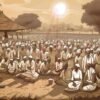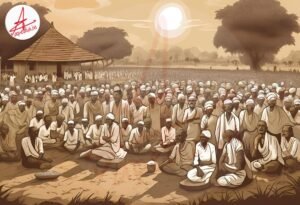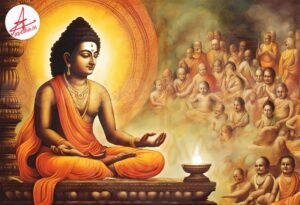Mahatma Gandhi’s Champaran Satyagraha (1917)
Champaran district, Bihar, India
First Satyagraha (non-violent resistance) led by Gandhi in India
Ended forced indigo cultivation, marking a new era of mass mobilization and Gandhian leadership in India’s freedom struggle
Introduction: Gandhi’s Return to India
After spending over two decades in South Africa, where he developed his philosophy of non-violent resistance (Satyagraha), Mohandas Karamchand Gandhi returned to India in 1915. His experiences in South Africa shaped his belief in justice, equality, and non-violent protest. In India, Gandhi was largely unknown to the public initially, but he was soon invited to lead a significant struggle in Champaran, Bihar, against oppressive practices by British landlords.
The Context of Champaran: Oppression of Farmers
In Champaran, local farmers were being exploited under the Tinkathia System. Under this system, British landlords forced Indian farmers to grow indigo on a portion of their land (often 3/20th or more), which was then sold at unfairly low prices. Farmers suffered as this indigo was in high demand in Europe, yet they gained almost nothing from it. The land was degraded, and they were burdened with various taxes and debts.
Gandhi’s Arrival in Champaran
In early 1917, Gandhi was approached by local leaders, including Raj Kumar Shukla, who requested him to visit Champaran and witness the plight of the farmers. Gandhi agreed and traveled to Champaran despite warnings from British authorities. His presence in Champaran was a direct challenge to British authority, as it showed his commitment to understanding and fighting local issues.
The Champaran Satyagraha
Gandhi’s approach to addressing the crisis in Champaran marked the beginning of Satyagraha in India. He gathered firsthand accounts from the farmers, documented evidence of the atrocities, and then sought an open dialogue with the authorities. Gandhi encouraged the people to speak the truth fearlessly and stand united.
When he was ordered to leave Champaran by the British authorities, Gandhi refused and was arrested. This created a public outcry, and the government, feeling the pressure, eventually released him. The trial further solidified his reputation as a leader willing to face jail time for justice.
Negotiations and Success
Through continuous dialogue and peaceful pressure, Gandhi was able to negotiate with the authorities. A commission was set up to examine the grievances of the farmers, with Gandhi as a member. After a series of investigations and discussions, the British agreed to abolish the Tinkathia System. The farmers received relief from indigo cultivation, marking one of the first victories of the Indian independence movement.
Impact on India’s Freedom Struggle
The Champaran Satyagraha was not only a victory for Champaran’s farmers but also marked a turning point in India’s struggle for independence. For the first time, Indians had successfully mobilized under Gandhi’s leadership, using non-violent resistance to win against an oppressive system. This movement:
- Popularized Non-violent Resistance: Champaran validated non-violence as a powerful tool against colonial rule.
- Increased Gandhi’s Influence: Gandhi emerged as a national leader and a symbol of hope.
- Empowered Rural India: The movement showcased the power of rural and agricultural communities in the freedom struggle.
Legacy of Champaran
Champaran set the stage for future movements led by Gandhi, including the Kheda Satyagraha (1918), Non-Cooperation Movement (1920-22), Salt March (1930), and ultimately, the call for Quit India (1942). Champaran laid the foundation for India’s mass mobilization, bringing ordinary Indians into the freedom struggle.
Conclusion
Gandhi’s involvement in Champaran was a pivotal moment that redefined the Indian independence movement. It demonstrated that ordinary people could resist and challenge the British regime through peaceful means. Champaran remains a symbol of courage and the power of unity, marking the beginning of Mahatma Gandhi’s journey as the foremost leader of India’s freedom movement.








